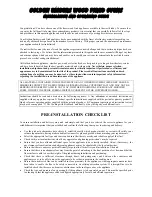
Installation and Operating Instructions for Bohemia Multi Fuel Stoves
Page
2 of 6
period. If the stove is fitted in place of an open fire then the chimney should be swept one month after installat ion to
clear any soot falls wh ich may have occurred due to the difference in combustion between the stove and the open fire.
In situations where it is not possible to sweep through the stove the installer will have provided alternative means such
as a soot door. After sweeping the chimney, the stove flue outlet and the flue pipe connecting the stove to the chimney
must be cleaned with a flue brush.
When installed with a top flue outlet it is possible to sweep through the Bohemia Stoves. Remove the baffle, and access
can be gained to the flue pipe.
The connecting flue pi pe and stove baffle shoul d be checke d monthl y to cle ar any fl y ash or soot de posits.
USE OF A FIREGUARD
When using the stove in situations where children, aged and/or infirm persons are present a fireguard must be used to
prevent accidental contact with the stove. The fireguard should be manufactured in accordance with BS6539.
INSTRUCTI ONS FOR US E:
First Firing
The stove has been treated with a heat-resistant coating, which hardens at a temperature of approximately 250
0
C. Th is
hardening process causes the production of smoke and malodorous fumes, so the room must be very we ll vent ilated.
During the first firing,
which should be carried out using approximate ly 1 kg of wood, the stoking door must be left
slightly open and must not be closed until the stove is cold. This is to prevent the sealing rope sticking to the stove.
RECOMMENDED FUELS
The recommended fuel to be burnt on these stoves is wood logs.
PLEAS E NOTE THAT ALL THE BOHEMIA STOVES HAVE OB TAINED APPROVAL FROM HETAS LTD.,
FOR B URNING WOOD LOGS ONLY.
It should also be noted that it is an offence to burn wood logs in the stov e if it is
installed within a Smoke Control Area.
Correct firing provides optimal heat output and ma ximu m econo my. At the same time , correct firing prevents
environmental da mage in the form of s moke and ma lodorous fumes and also reduces the risk of chimne y fires.
Well seasoned wood fuel is essential for correct use. Make sure your fuel is kept dry. If the fuel is wet, a large
proportion of the heat will be used to vaporize the water, and this energy will disappear up the chimney. It is clearly not
only uneconomica l to fire with wet fuel but also, as mentioned above, increases the risk of producing soot, smoke and
other environmentally da maging by-products. When wood is used as a fuel it is important that it is dry, i.e. wood with
mo isture content less than 20%. Ideally firewood needs seasoning for at least 2 summe rs, logs should be stacked in a
well ventilated situation, and logs over 100mm dia meter should be split. The stack should be protected from ra in but
re main we ll ventilated.
MIXED FUEL US E
PLEAS E NOTE THAT HETAS LTD APPLIANCE APPROVAL ONLY COVERS THE US E OF WOOD LOGS
ON THIS APPLIANCE. HETAS LTD APPROVAL DOES NOT COVER THE US E OF OTHER FUELS EITHER
ALONE OR MIXED WITH THE RECOMMENDED FUELS LISTED ABOVE, NOR DOES IT COVER
INSTRUCTIONS FOR THE US E OF OTHER FUELS .
Use of brown coal and smokeless fuel
Uni-logs (brown coal brickettes) may be burned on the stove. Good performance will be obtained using these brickettes.
Approved smoke less solid fuels may also be used. Avoid over firing. A mixtu re of seasoned wood and smokeless fuel
will provide e xtended burn times with a good fla me picture.
Use of Pe troleum c oke and li qui d fuels
will invalidate the guarantee and
must not be use d
as this will cause the stove
to “over fire”. Operating at temperatures in excess of 500ºC will cause irreparable damage which is not covered by the
guarantee.
It is essential when burning smoke less solid fuels that the ashpan is emptied on a daily basis. Ash must not be allowed
to build up below the grate. Note brown coal and smo keless fuel should also be stored dry and ventilated.
LIGHTING AND COMBUSTI ON
The prima ry air is drawn into the stove through the slide on the door. The secondary air is regulated with the aid of a
slider above the door. The heated secondary air flo ws down the viewing window and then feeds the fire; it is this
secondary combustion that completes the burning cycle by turning unburned volatiles into fla me.
As much as half of the heat obtainable fro m wood is obtained from this secondary combustion. It is important that the
firebo x temperature is ma intained at a high level as this also aids complete combustion. The use of a stove pipe
thermo meter is recommended, as this will indicate stove performance. For e xa mp le, when first lighting a stove it is
important to get it really hot before closing the burning rate down. The firebox te mperature should reach 400 °C which
equates to approximately 250 °C at the flue pipe
























